Overview
This article explores the various alternative names for Type 2 Diabetes, highlighting how important terminology is in understanding and managing this condition effectively. It's understandable to feel confused by the different terms, such as 'Adult-Onset Diabetes' and 'Non-Insulin-Dependent Mellitus.' These names have become less relevant as diabetes increasingly affects younger populations. This shift underscores the need for inclusive language that reflects the evolving nature of diabetes. By using terms that resonate with all ages, we can better support patient education and engagement.
You're not alone in this journey. Recognizing the importance of language can empower you and others affected by diabetes. It’s crucial to foster a dialogue that encourages understanding and connection within the community. As we navigate through these changes together, remember that we are here to support you every step of the way. If you have any questions or need further resources, please don’t hesitate to reach out.
Introduction
In the realm of chronic health conditions, Type 2 Diabetes emerges as a complex and increasingly prevalent challenge, affecting millions worldwide. This metabolic disorder, characterized by insulin resistance and elevated blood sugar levels, is not merely a personal health issue; it carries significant societal and economic implications. As the landscape of diabetes evolves, so too does the language used to describe it, reflecting changing demographics and advancements in medical understanding.
It's understandable to feel overwhelmed by alarming trends indicating a rise in diagnoses among younger populations. The importance of accurate terminology and effective management strategies has never been more critical. From innovative technological solutions to community support initiatives, exploring the multifaceted nature of Type 2 Diabetes reveals a pressing need for awareness, education, and empowerment.
You're not alone in this journey. Together, we can navigate this pervasive health crisis, fostering a sense of community and support that is essential for those affected. We are here to support you every step of the way.
Define Type 2 Diabetes
This condition, often known as diabetes type 2, is a chronic metabolic disorder characterized by elevated blood sugar levels due to insulin resistance and a relative deficiency in insulin production. Unlike the first form of diabetes, where the pancreas fails to produce insulin, individuals with the second form can produce insulin, but their bodies do not utilize it effectively. This condition typically develops gradually and is closely linked to factors such as obesity, a sedentary lifestyle, and genetic predispositions.
At T2DSolutions, we understand the challenges faced by newly diagnosed patients. Our mission is to provide comprehensive resources and support to help you manage your condition effectively. Diabetes type 2 is the most prevalent form of this condition worldwide, accounting for roughly 90-95% of all cases. The financial strain of this condition in the U.S. is overwhelming, totaling approximately $379.9 billion, highlighting the pressing need for efficient oversight and prevention tactics. Symptoms often include increased thirst, frequent urination, fatigue, and blurred vision; however, many individuals may remain asymptomatic for years, complicating early diagnosis and intervention.
Recent studies indicate that diabetes prevalence varies significantly by age, with older adults being more affected. Alarmingly, there is a rising trend in diagnoses among younger populations due to lifestyle factors. It's understandable to feel concerned about these demographic trends, as comprehending them is essential for customizing effective prevention and oversight strategies. Focused measures can be designed for specific age groups to address their unique challenges. Moreover, advancements in technology, such as artificial intelligence systems, are being employed to develop personalized health care plans. These platforms examine genetics, gut bacteria, and lifestyle habits, aiming to lower the risk of diabetes-related conditions and enhance patient outcomes. As D Trico observes, the incorporation of such technologies can greatly improve the management of this condition, offering tailored solutions that cater to personal needs.
As studies progress, the emphasis on insulin resistance and its management techniques remains crucial in tackling the increasing epidemic of this illness. The latest discoveries highlight the significance of lifestyle changes and community support in managing this condition effectively. At T2DSolutions, we are committed to empowering you with the knowledge and tools necessary to navigate your diabetes journey. Remember, you're not alone in this journey; we are here to support you every step of the way.
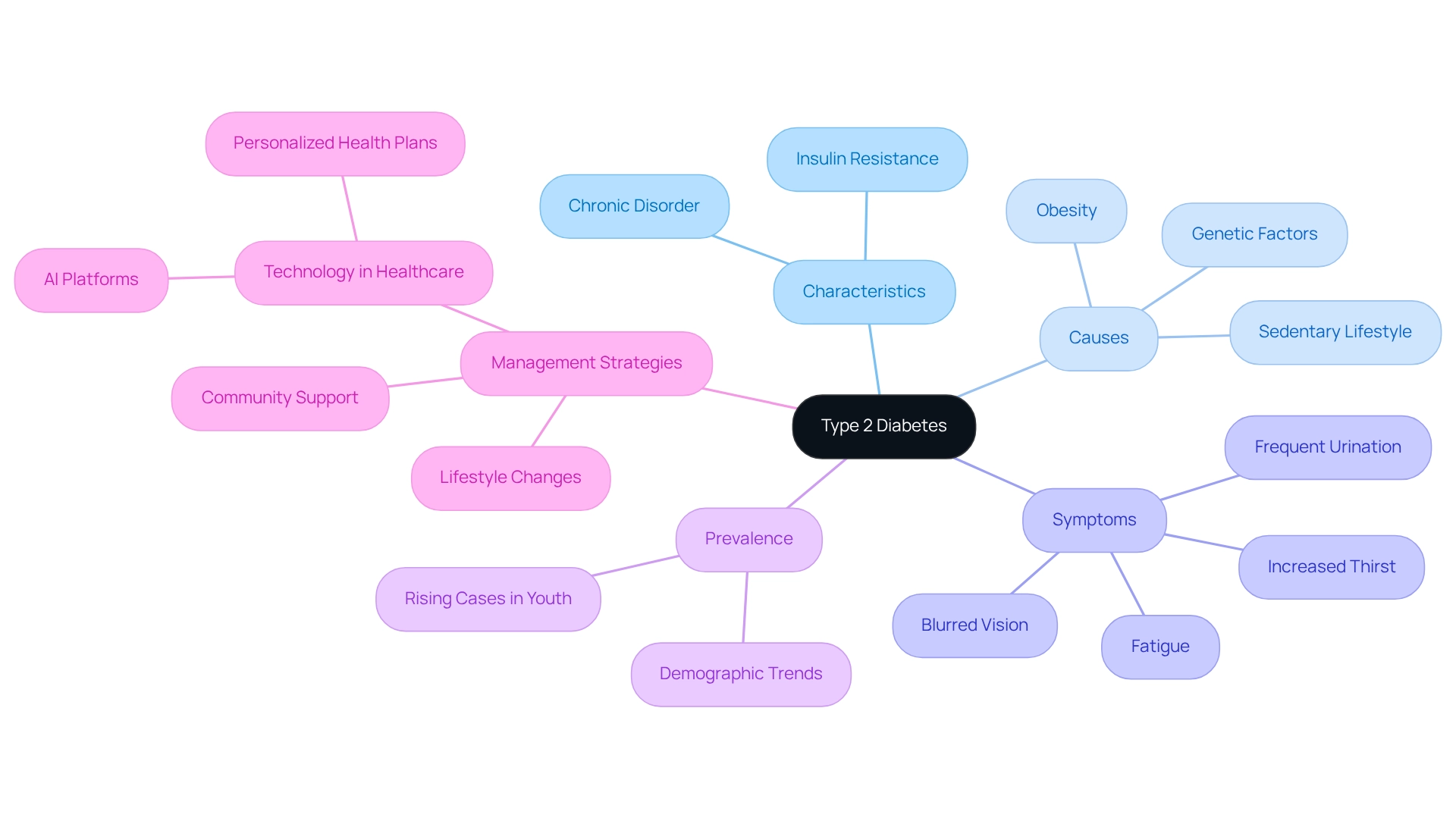
Explore Alternative Names for Type 2 Diabetes
Condition 2, often referred to by various alternative terms, includes another name for diabetes type 2 that highlights its characteristics and the populations it impacts. Historically, terms like 'Adult-Onset Condition' and 'Non-Insulin-Dependent Mellitus (NIDDM)' have been prevalent. 'Adult-Onset Diabetes,' another name for diabetes type 2, gained recognition as the condition was primarily identified in adults. However, with the rising rates of obesity, we now see more diagnoses in children and teenagers, making this term less relevant today.
The label 'Non-Insulin-Dependent Mellitus,' another name for diabetes type 2, emphasizes that individuals with this condition generally do not require insulin treatment for survival, distinguishing it from diabetes type 1. This terminology is important as it reflects our evolving understanding of the disease, which is another name for diabetes type 2, and its treatment. For instance, the American Diabetes Association highlights that effective blood sugar management enables many individuals with the illness to lead fulfilling, active lives.
Statistics indicate that the annual relative increase of Type 2 diabetes, another name for diabetes type 2, in the U.S. from 2002 to 2012 was 4.8 percent. This emphasizes the growing prevalence of the condition and the significance of terminology changes. Recent updates in 2025 have sparked discussions about the implications of terms like 'Adult-Onset Condition.' Experts express concern that retaining the term 'another name for diabetes type 2' may mislead patients about the nature of the disease, especially as it increasingly affects younger populations. Case studies, such as 'Stress Management in Diabetes Care,' demonstrate that using alternative terms in patient education can enhance comprehension and engagement, particularly among diverse demographics.
The historical usage of 'Adult-Onset Diabetes,' another name for diabetes type 2, has diminished, transitioning towards more inclusive language that reflects the condition's broader impact. This shift is crucial for fostering awareness and understanding, as terminology, like another name for diabetes type 2, can significantly shape perceptions across different age groups and communities. By discussing these alternative terms and their implications, T2DSolutions aims to empower individuals with the knowledge necessary for effective condition management. T2DSolutions also offers valuable resources and contact information for local health departments and community ambassadors, reinforcing its commitment to community engagement and support. For more information and resources, please visit T2DSolutions to stay informed and connected.
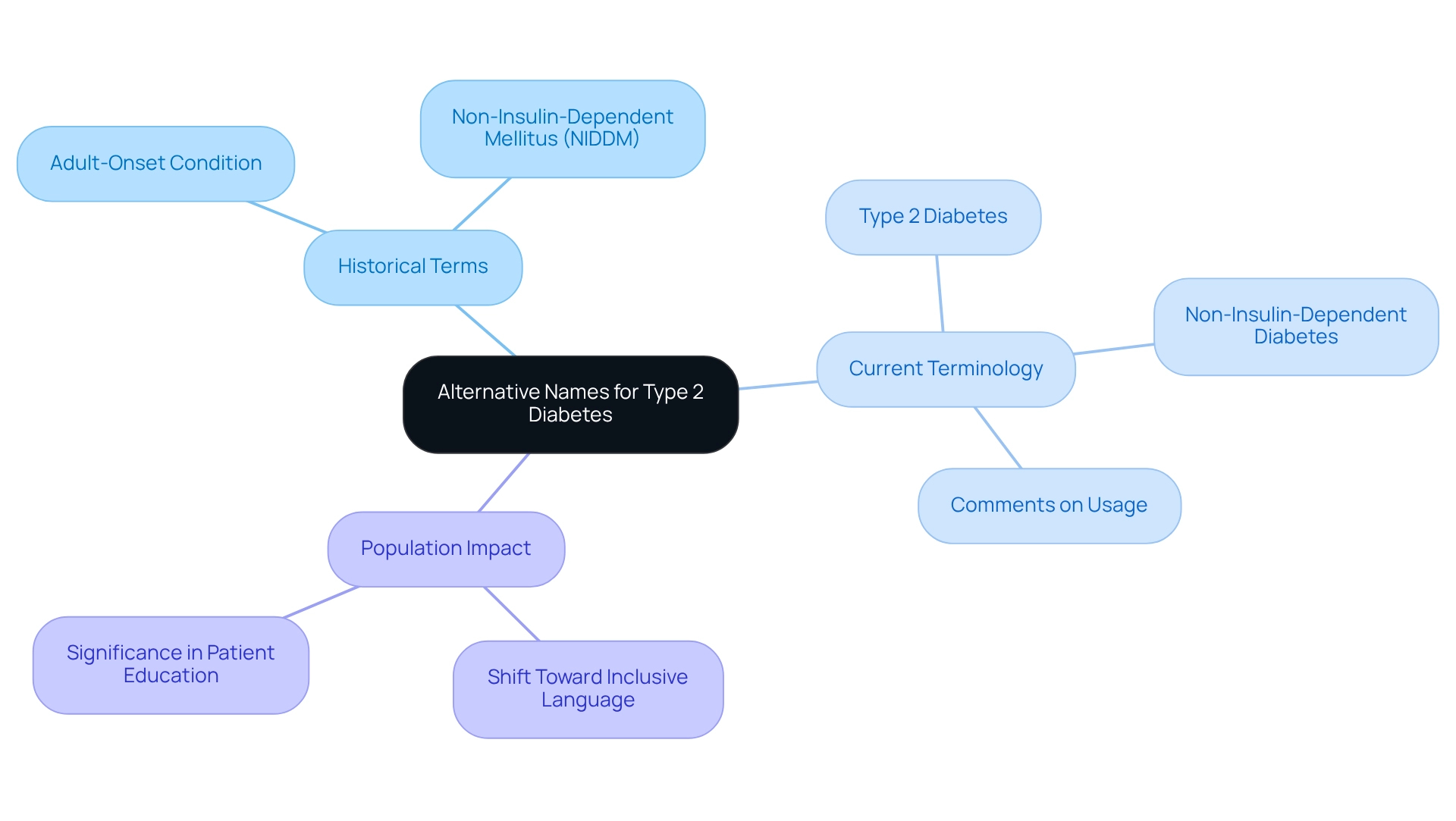
Understand the Importance of Terminology in Diabetes Management
Efficient communication in blood sugar regulation is essential, and it greatly depends on the language used by healthcare professionals. Accurate language not only clarifies the condition but also enhances understanding of treatment options and encourages adherence to management plans. For instance, using 'insulin resistance' instead of 'failure' can reduce stigma and foster a more positive approach to managing the condition. Adopting person-first language—such as 'person with a condition' rather than 'diabetic'—is increasingly recognized for its ability to highlight the individual over the illness. This shift can significantly boost patient involvement, reduce feelings of shame, and ultimately lead to better health outcomes.
It's important to acknowledge that the average medical costs for individuals diagnosed with this condition are 2.6 times greater than those without it. This statistic highlights the financial consequences of effective oversight and the pressing need for clear communication. Additionally, a staggering 267,000 emergency department visits for hyperglycemic crises among adults with high blood sugar in 2020 emphasize the urgent necessity for improved education and management strategies. By utilizing appropriate terminology, healthcare providers can create a supportive environment that empowers individuals to take control of their health, improving adherence to treatment and overall quality of life.
As D Trico emphasizes, the language used in healthcare settings can significantly influence patient experiences and outcomes. Clear, compassionate communication is crucial for cultivating resilience and hope among those facing the challenges of this condition, also known as diabetes type 2, especially given its increasing prevalence worldwide. At T2DSolutions, we aim to educate patients about the importance of such terminology, linking it to our mission of providing comprehensive resources and community support for those newly diagnosed. Remember, you're not alone in this journey; we are here to support you every step of the way.
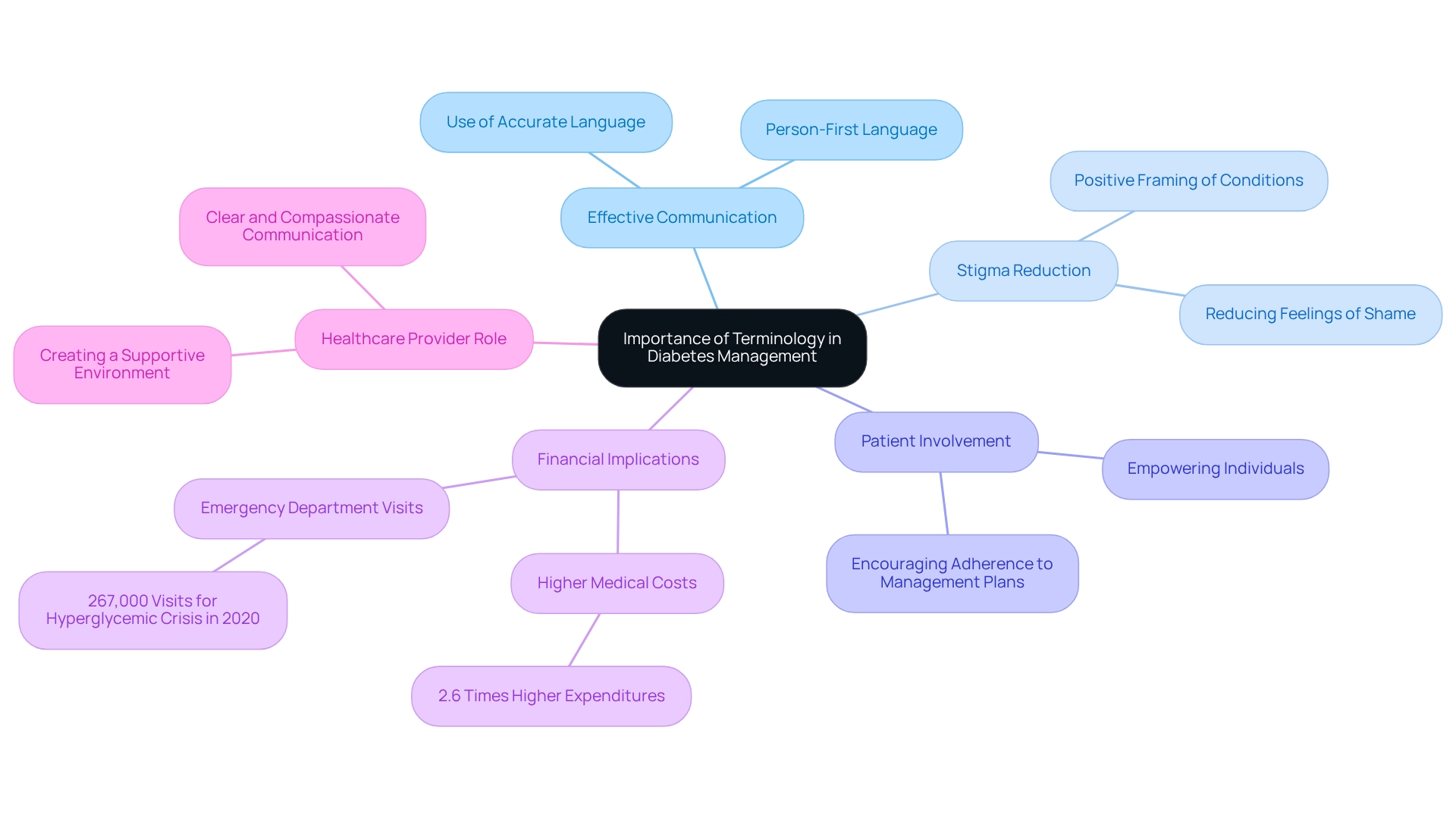
The Evolution of Diabetes Terminology
The terminology surrounding this condition has evolved significantly, reflecting both advancements in medical research and shifts in societal perspectives. Initially, the condition was primarily classified into two types based on age of onset and treatment needs, with diabetes type 2 being one of those categories. However, as research has progressed, our understanding of the disease's pathophysiology has deepened, leading to more nuanced classifications such as 'Type 2' and 'Type 3.' The latter is increasingly recognized for its association with cognitive decline and Alzheimer's disease, underscoring the complexity of this multifaceted condition.
It's understandable to feel concerned about these changes. The transition from terms like 'adult-onset diabetes' to more inclusive language reflects a troubling rise in cases of the second variant among younger populations. Recent statistics reveal that nearly 60% of global expenses related to this health issue are borne by low- and middle-income countries, highlighting the urgent need for accessible primary care systems and resources aimed at lifestyle changes.
Historical case studies reveal significant racial disparities in the prevalence of diabetes type 2, particularly among non-Hispanic Blacks, Hispanics, and certain Asian subgroups. These disparities emphasize how socioeconomic factors and environmental conditions can influence the disease's occurrence, calling for targeted health interventions to address these inequities.
This evolution in terminology not only signifies scientific progress but also aims to reduce stigma and encourage a comprehensive understanding of the condition's management. By embracing these changes, healthcare providers can better meet the diverse needs of patients, ultimately improving care outcomes and fostering a more informed approach to diabetes-related challenges. As noted by ME, "ME reports a charitable grant from Youth Health Programme of AstraZeneca, outside the submitted work," which highlights the importance of funding and support for ongoing research in this area. Furthermore, the shifting prevalence patterns of the condition, with low- and middle-income nations now leading in adult cases, necessitate a reevaluation of healthcare strategies to effectively tackle this growing public health challenge. You're not alone in this journey; we are here to support you every step of the way.
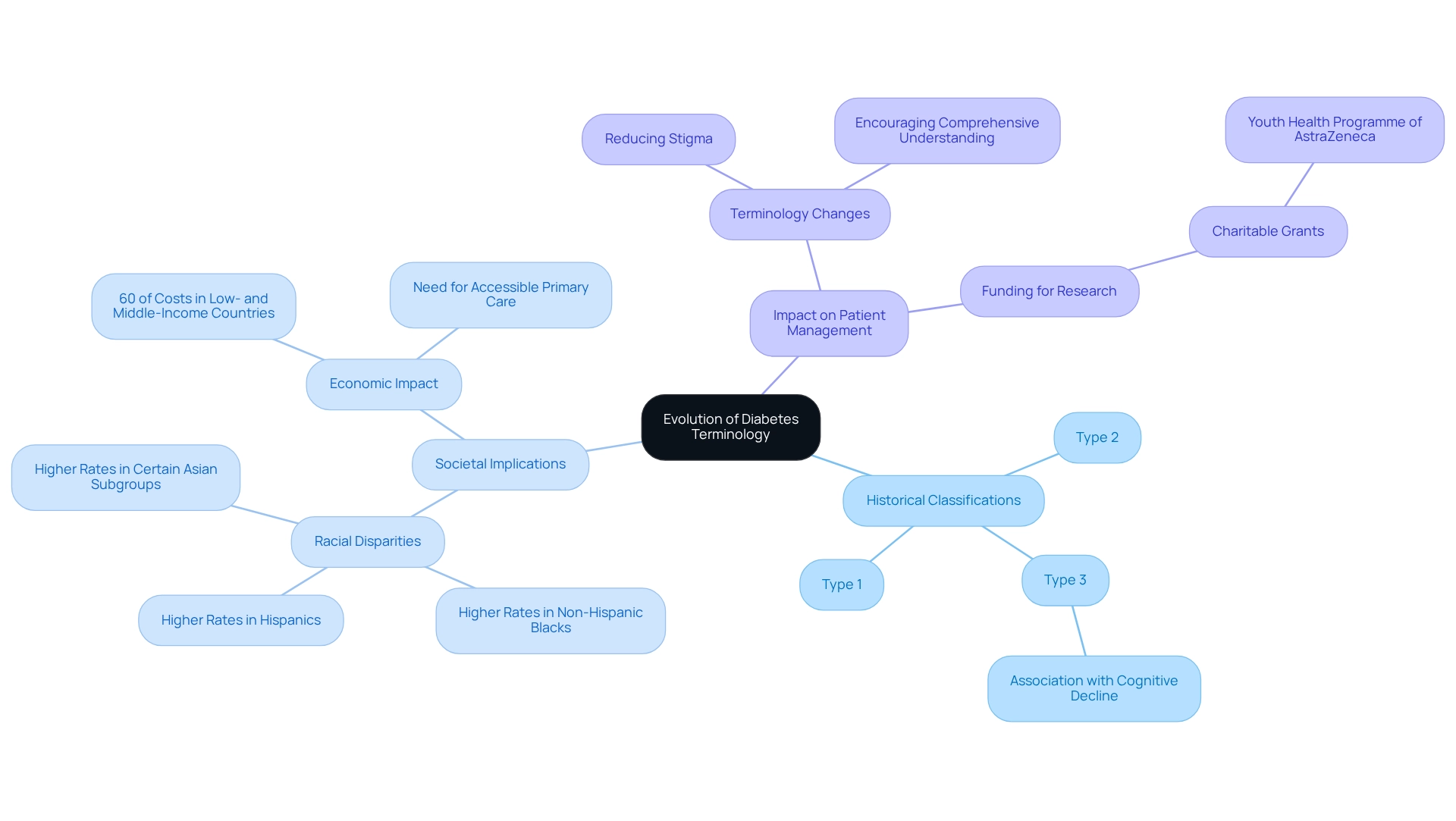
Current Trends in Diabetes Terminology and Management
Present trends in diabetes-related terminology and management highlight the vital role of personalized care and technological advancements in treatment. At T2DSolutions, we aspire to be a leading resource hub for individuals managing Type 2 conditions—another name for diabetes type 2—by offering essential education and community support. Terms like 'prediabetes' and 'metabolic syndrome' are increasingly recognized, as healthcare providers acknowledge the spectrum of risk associated with glucose metabolism. The integration of digital health tools, such as continuous glucose monitors and mobile health applications, is transforming the care of diabetic patients, enabling real-time data tracking and tailored feedback.
It's crucial to understand that, according to the ONC 'Final Rule,' regulations against information blocking play a significant role in ensuring healthcare providers can effectively utilize these digital tools, ultimately enhancing patient care. Furthermore, the focus on comprehensive methods—covering mental health assistance and lifestyle changes—is evident in the evolving terminology around conditions like diabetes type 2. By using inclusive and empowering language, healthcare providers can create a supportive environment that encourages proactive management of diabetes type 2.
Statistics indicate that the use of digital health tools in managing blood sugar conditions is on the rise, with many patients reporting improved outcomes through personalized treatment strategies. For instance, innovations in wearable technology for hypoglycemia detection, as highlighted in the case study titled "Future of Wearable Hypoglycemia Alarms," could significantly enhance safety and quality of life for individuals with blood sugar issues by providing timely notifications for hypoglycemic events.
As the landscape of blood sugar management continues to evolve, T2DSolutions is committed to integrating technology and personalized approaches to enhance patient experiences and health outcomes. However, the growth of the smart insulin pen market faces challenges, particularly for patients requiring a mixture of two types of insulins. This indicates that while technology is advancing, there are still barriers to overcome. Insights from experts, including Agnese Galeazzi and her colleagues, shed light on the expanding inequity in diabetes prevalence and treatment globally, reinforcing the need for tailored care strategies that address these disparities. You're not alone in this journey, and we are here to support you every step of the way.
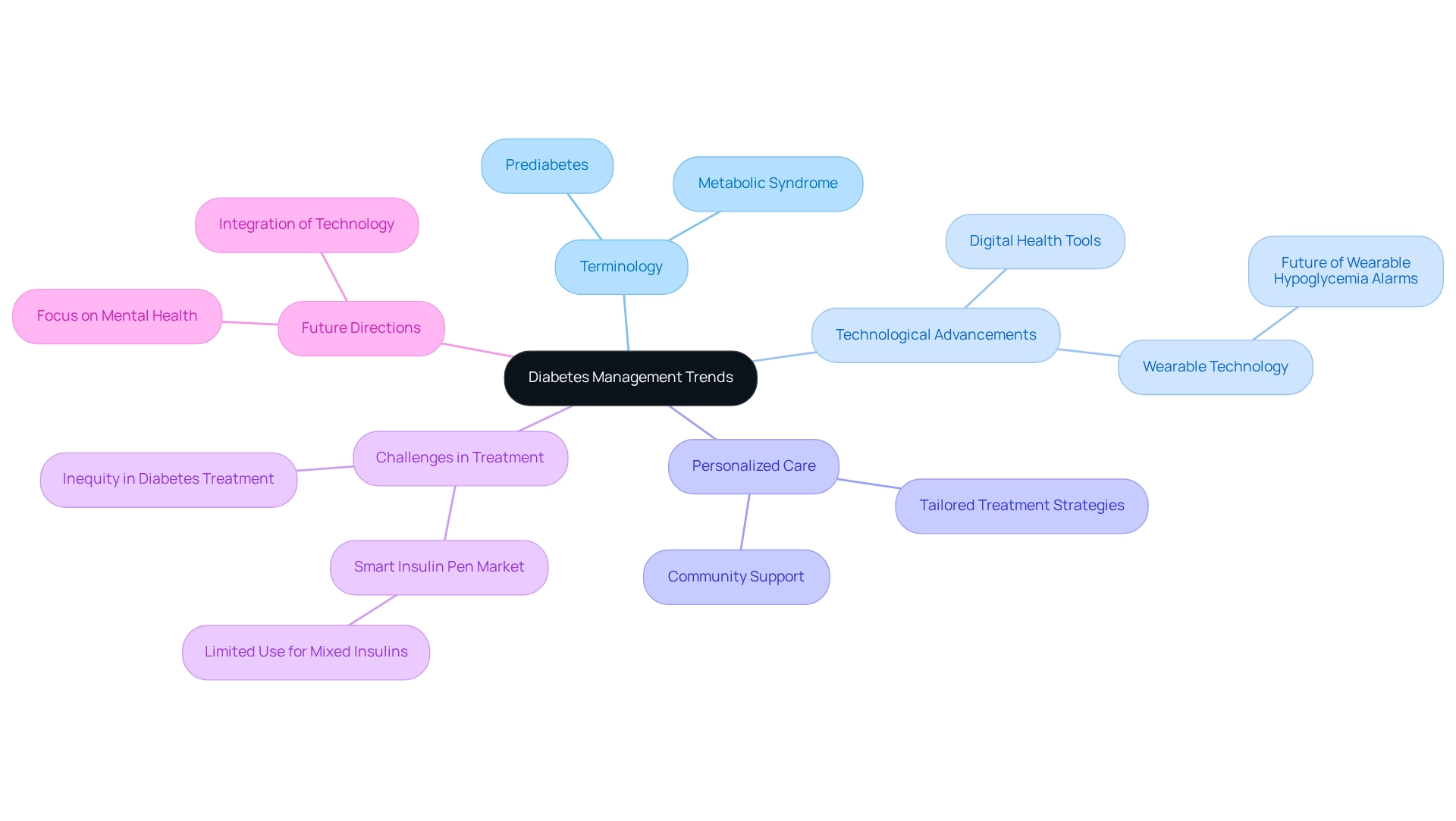
Conclusion
Type 2 Diabetes is a multifaceted challenge that impacts not only individual health but also has significant societal and economic implications. Understanding the complexities of this condition—ranging from its definition and evolving terminology to the critical role of effective management strategies—serves as a foundation for addressing its increasing prevalence. The rise in diagnoses, particularly among younger populations, highlights the urgent need for tailored interventions and community support.
It's important to emphasize the value of accurate terminology, as it fosters a more constructive dialogue around diabetes. By shifting language to be more inclusive and person-centered, healthcare providers can enhance patient engagement and adherence to treatment plans. This compassionate approach not only reduces stigma but also empowers individuals to take control of their health, ultimately leading to better outcomes.
As advancements in technology and personalized care continue to reshape diabetes management, the commitment to education and community resources remains vital. Initiatives that promote awareness and support can significantly impact the lives of those navigating Type 2 Diabetes. By working together, we can cultivate a more informed and supportive environment, enabling individuals to thrive in their diabetes journey. Remember, you're not alone in this journey, and together, we can contribute to a healthier society overall.
Frequently Asked Questions
What is diabetes type 2?
Diabetes type 2 is a chronic metabolic disorder characterized by elevated blood sugar levels due to insulin resistance and a relative deficiency in insulin production. Unlike type 1 diabetes, individuals with type 2 can produce insulin but do not utilize it effectively.
What factors contribute to the development of diabetes type 2?
The development of diabetes type 2 is closely linked to factors such as obesity, a sedentary lifestyle, and genetic predispositions.
How prevalent is diabetes type 2?
Diabetes type 2 is the most prevalent form of diabetes worldwide, accounting for approximately 90-95% of all cases.
What are the financial implications of diabetes type 2 in the U.S.?
The financial strain of diabetes type 2 in the U.S. is significant, totaling around $379.9 billion, highlighting the need for effective management and prevention strategies.
What are common symptoms of diabetes type 2?
Common symptoms include increased thirst, frequent urination, fatigue, and blurred vision; however, many individuals may remain asymptomatic for years, complicating early diagnosis.
How does age affect the prevalence of diabetes type 2?
Recent studies indicate that diabetes prevalence varies significantly by age, with older adults being more affected. There is also a rising trend in diagnoses among younger populations due to lifestyle factors.
What advancements are being made in managing diabetes type 2?
Advancements such as artificial intelligence systems are being employed to develop personalized health care plans that consider genetics, gut bacteria, and lifestyle habits to lower diabetes-related risks and enhance patient outcomes.
What role do lifestyle changes and community support play in managing diabetes type 2?
Lifestyle changes and community support are crucial in effectively managing diabetes type 2, as they can significantly improve patient outcomes.
What are alternative names for diabetes type 2?
Alternative names for diabetes type 2 include "Adult-Onset Diabetes" and "Non-Insulin-Dependent Mellitus (NIDDM)," though the term "Adult-Onset" is becoming less relevant due to rising diagnoses in younger populations.
Why is terminology important in understanding diabetes type 2?
The terminology used to describe diabetes type 2 is important as it reflects the evolving understanding of the disease and its treatment, influencing patient perceptions and education.
How can individuals find support and resources for managing diabetes type 2?
Individuals can find support and resources for managing diabetes type 2 through organizations like T2DSolutions, which offers valuable information and connects patients with local health departments and community ambassadors.



